Seven Ways to Add Value After "Deferred Maintenance"
Nearly every college and university seeks to make better use of its space. Institutions facing enrollment shortages need to maximize space efficiency in order to decrease operational expenses. Institutions in growth mode, too, need to modernize and upgrade existing real estate, while negotiating post-COVID budgetary pressures. For both, the need to maximize return on investment is constant.
At the same time, deferred maintenance is always a challenge. Most campus facilities were constructed in two waves: alongside the Baby Boomers in 1960-’75 and the Millennial generation in the 1990s and 2000s, making them 50 and 25 years old, respectively, when building infrastructure most frequently needs repair.
Done properly, however, these “infrastructure first” renovations can address deferred maintenance — effectively decreasing the age of an existing structure and preparing it for 21st-century use — while also maximizing revenue and repositioning an institution to make it more attractive to students and faculty.
Daniel Topping, a principal at NK Architects, and Todd Miller, assistant vice president for campus planning, design, and construction for New Jersey Institute of Technology (NJIT), presented some of their strategies for addressing deferred maintenance on university campuses at ERAPPA 2022.
Here are just a few ways to add value to a facility renewal:
1. Support New Pedagogical Models
More and more, education is become hierarchical and more collaborative and interactive — and facility upgrades are the perfect time to reorganize academic space accordingly.
Thanks to a contemporary model of “onstage/offstage” space planning, the pediatric optometry suite at SUNY College of Optometry makes medical education more collaborative, by staggering exam rooms around a central staff area where students and faculty collaborate.
SUNY College of Optometry
SUNY College of Optometry
Rutgers University, Olson Hall
2. Expand STEM Programs
Special-use buildings such as laboratories present a particular opportunity: because their infrastructure needs are so intensive, and STEM programs currently so in demand, they are often one of the first, most high-return spaces to upgrade.
To improve the quality of chemistry education on the Piscataway campus, Rutgers renovated labs in Olson Hall to include all-new ventilation, casework, fume hoods and fume extractor arms, as well as a brighter environment overall.
NJIT Microfabrication Lab
3. Generate Revenue
Upgraded facilities can become additional sources of revenue, by allowing colleges and universities to connect with external clients for hosting events, leasing incubator space, commercializing R&D, and more.
NJIT has monetized formerly run-down support space by converting it into a microfabrication lab that can be rented by third-party research enterprises.
4. Improve Health and Wellbeing
Research has proven that students and staff are healthier, happier, more creative and more productive when they work in places that connect to the outdoors, are naturally day-lit, encourage movement, and ensure air quality with healthy materials or natural ventilation.
By punching new windows into the walls of Rainis Auditorium, Saint Elizabeth University reconnected students to daylight and the outdoors, an important environmental component of mental health; raising the floor to ground level also improved accessibility for all.
Rainis Auditorium, Saint Elizabeth University - BEFORE
Rainis Auditorium, Saint Elizabeth University - AFTER
5. Improve Environmental Performance
New building infrastructure is often necessary to help aging facilities meet more stringent building codes and climate goals, which helps both the environment and — in the form of lower utility costs — an institution’s bottom line.
SUNY New Paltz’s Wooster Hall was made more energy-efficient with improved mechanical systems and a new, high-performance building envelope — which not only decreases utility costs, it also gives the building a fresh new look.
SUNY New Paltz, Wooster Hall - BEFORE
SUNY New Paltz, Wooster Hall - AFTER
Fairleigh Dickinson University, Animation Lab
6. Refresh / Rebrand / Reimagine
Sometimes an academic department — or an entire building — can be transformed with nothing more than refreshed materials and finishes, signaling to students and faculty a program’s importance to the overall mission of the institution.
The first space renovated in an aging 1960s arts building, the Animation Lab at Fairleigh Dickinson University compresses three programs — a computer lab, 3D print lab and pinup and motion-capture space — into one room to create a flexible, multifunctional, highly efficient space that reflects the vitality of the computer animation program.
William Paterson University, Hunziker Hall
7. Build Community
Whether to support collaborative pedagogies and group work, or socializing and community spirit, social spaces are increasingly central to the mission of higher education; best of all, they have modest infrastructure needs, making them easy to build when making improvements.
When renovating William Paterson University’s Hunziker and Preakness Halls, outdated classrooms were repurposed as lounges where students can collaborate, socialize or simply relax.










